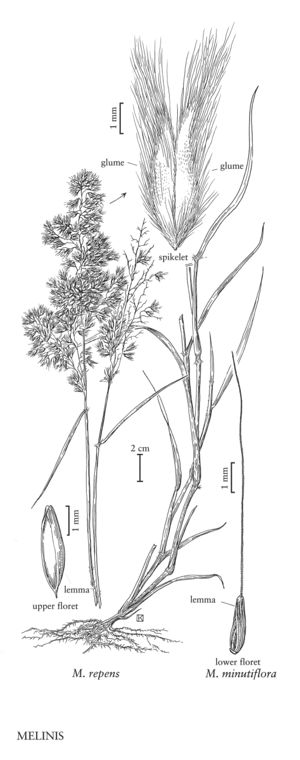Difference between revisions of "Melinis minutiflora"
imported>Volume Importer |
imported>Volume Importer |
||
| Line 43: | Line 43: | ||
|publication year= | |publication year= | ||
|special status=Introduced | |special status=Introduced | ||
| − | |source xml=https://bitbucket.org/aafc-mbb/fna-data-curation/src/ | + | |source xml=https://bitbucket.org/aafc-mbb/fna-data-curation/src/200273ad09963decb8fc72550212de541d86569d/coarse_grained_fna_xml/V25/V25_1308.xml |
|subfamily=Poaceae subfam. Panicoideae | |subfamily=Poaceae subfam. Panicoideae | ||
|tribe=Poaceae tribe Paniceae | |tribe=Poaceae tribe Paniceae | ||
Latest revision as of 18:56, 11 May 2021
Plants perennial; cespitose; aromatic. Culms (50)80-150 cm, branching and sprawling, often becoming matted, usually rooting at the lower nodes; upper nodes appressed pubescent; internodes glabrous basally, appressed pubescent distally. Sheaths densely tomentose, hairs 0.5-5.2 mm, spreading, papillose-based, often sticky and smelling of linseed oil; ligules of hairs, 1-2 mm; blades 3.5-19 cm long, 4-14 mm wide, flat, pubescent, hairs sometimes papillose-based. Panicles (4.5)7-20 cm long, 1-9.5 cm wide, narrowly ovate; primary branches to 8 cm; pedicels usually shorter than the spikelets, glabrous, scabridulous. Spikelets 1.7-2.4 mm, usually purplish; calluses glabrous. Lower glumes absent or to 0.3 mm, glabrous, scabridulous; upper glumes 1.6-2.4 mm, glabrous, unawned, sometimes muticous; lower florets sterile; lower lemmas bilobed, lobes 0.2-0.7 mm, unawned or awned, awns to 18 mm; lower paleas absent; upper lemmas 1.4-1.9 mm, glabrous; upper paleas 1.5-1.9 mm, usually slightly longer than the upper lemmas; anthers 3, 1-1.5 mm, reddish-brown to orange. Caryopses 0.9-1.2 mm long, 0.3-0.4 mm wide. 2n = 36.
Distribution
Puerto Rico, Pacific Islands (Hawaii), Fla.
Discussion
Melinis minutiflora is native to Africa, but has been introduced throughout the tropics as a forage crop. It is now regarded as a serious weed in many places. In the Flora region, it is only known to be established in southern Florida.
Selected References
None.
